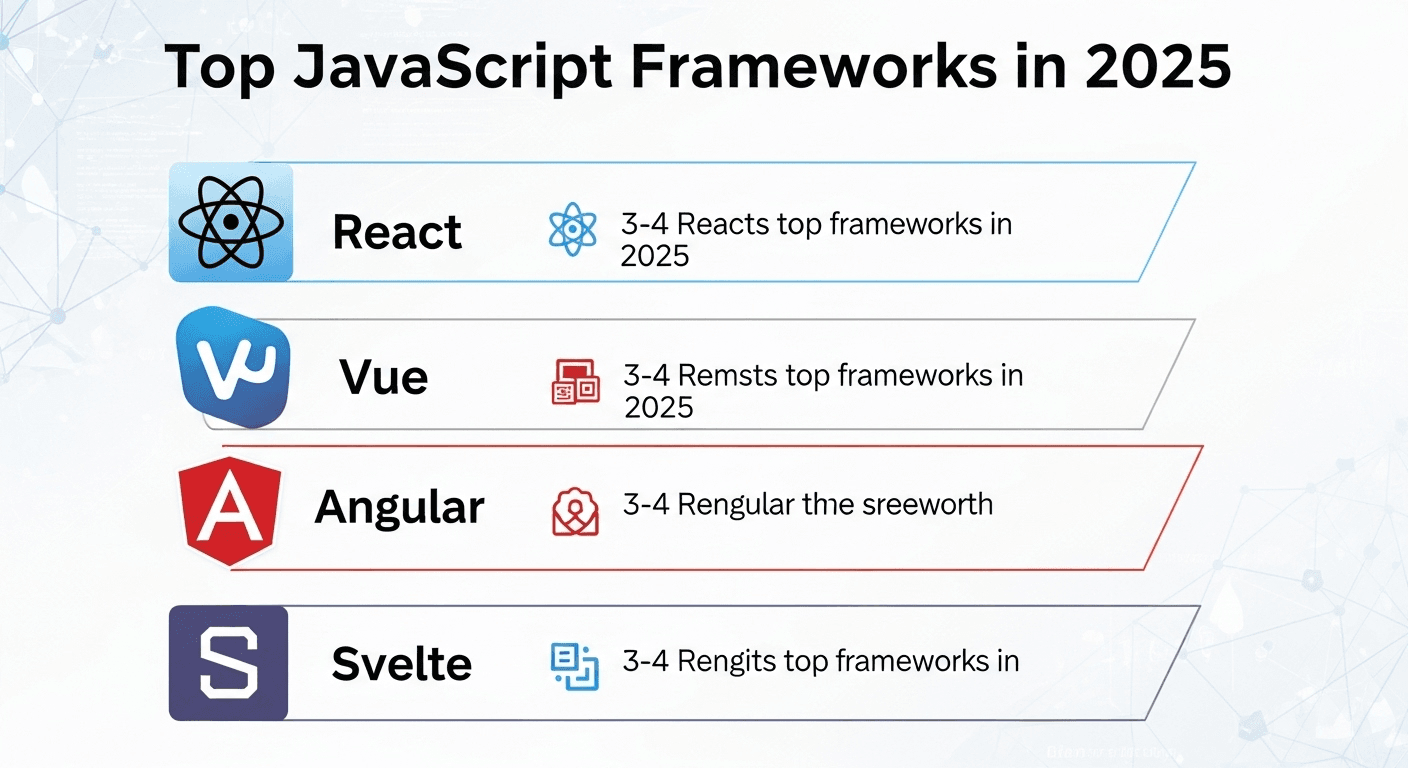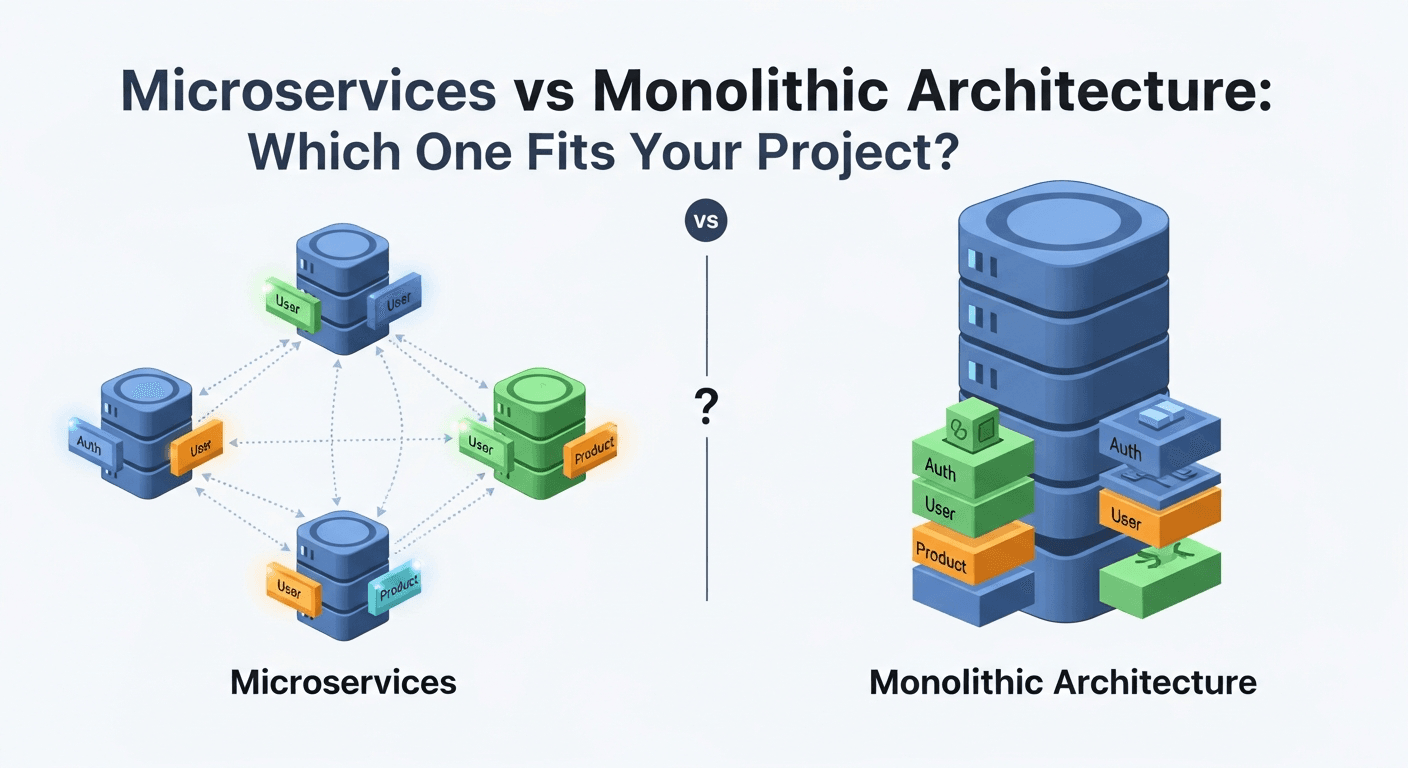JavaScript continues to dominate the web development world as the backbone of interactive and dynamic applications. Over the past decade, several frameworks and libraries have emerged to make building modern user interfaces faster and more efficient. Among them, React, Vue, Angular, and Svelte have consistently stood out as the top choices for developers.
As we step into 2025, the landscape of front-end development is more competitive than ever. Each framework offers unique strengths: React with its massive ecosystem, Vue with its simplicity, Angular with its enterprise-ready architecture, and Svelte with its lightweight performance-first approach. But with so many options, a common question arises: Which JavaScript framework should you learn or adopt for your next project in 2025?
In this article, we’ll explore the current state of these four major frameworks, their advantages, limitations, and the use cases where they shine. By the end, you’ll have a clearer picture of which framework best aligns with your skills, team, or business goals.
React in 2025
React remains one of the most widely used JavaScript libraries in 2025. Backed by Meta (formerly Facebook) and supported by a massive open-source community, React has set the standard for component-based architecture in front-end development. Its flexibility and scalability continue to make it the first choice for many developers and companies worldwide.
Strengths of React
- Huge Ecosystem: From UI libraries like Material UI to frameworks such as Next.js, React’s ecosystem is unmatched. This gives developers countless tools and integrations to build anything from small websites to enterprise-grade applications.
- Flexibility: React is not opinionated, meaning you can integrate it with different architectures, state management tools (Redux, Zustand, Recoil), and backend solutions.
- Strong Community Support: With millions of developers, React has extensive documentation, tutorials, and open-source contributions, making problem-solving much easier.
- Performance Optimizations: Features like concurrent rendering and server components make React highly optimized for modern web applications.
Limitations of React
- Steep Learning Curve for Beginners: While writing simple components is easy, understanding hooks, state management, and advanced concepts like context or server-side rendering can be overwhelming for newcomers.
- Heavy Dependence on Third-Party Tools: Unlike Angular, React does not provide a full-fledged framework. Developers often rely on external libraries for routing, state management, and form handling, which can lead to fragmented solutions.
Best Use Cases for React in 2025
- Large-scale applications requiring flexibility and scalability.
- Startups that want to leverage a strong talent pool and proven ecosystem.
- Teams aiming to build high-performance apps with advanced features like server-side rendering or static site generation.
Vue in 2025
Vue has steadily grown into one of the most beloved JavaScript frameworks, and in 2025 it continues to be a popular choice for both beginners and experienced developers. Created by Evan You and maintained by a strong open-source community, Vue strikes a balance between simplicity and powerful functionality.
Strengths of Vue
- Beginner-Friendly: Vue is known for its gentle learning curve. Its syntax is intuitive, making it easy for developers to pick up quickly, even if they are new to front-end frameworks.
- Clean and Readable Code: Vue’s single-file components (HTML, CSS, and JavaScript in one file) allow for clean organization, which is especially helpful in small to medium projects.
- Flexible and Progressive: Vue can be adopted incrementally. Developers can use it for just a small part of an application or build a full-scale project entirely with Vue.
- Growing Ecosystem: Tools like Vue Router for navigation and Pinia (a modern replacement for Vuex) for state management make building applications more efficient.
Limitations of Vue
- Smaller Enterprise Adoption: Compared to React and Angular, Vue is less common in large corporations, which may limit job opportunities in certain regions.
- Ecosystem Still Developing: While Vue’s ecosystem is solid, it doesn’t yet match the sheer size and variety of React’s libraries and tools.
Best Use Cases for Vue in 2025
- Startups and small businesses looking for a fast and cost-effective development solution.
- Developers who prefer clean, readable, and maintainable codebases.
- Applications that need to get to market quickly without a steep learning curve.
Angular in 2025
Angular, backed by Google, remains a powerful framework in 2025, especially for enterprise-level applications. Unlike React or Vue, Angular is a full-fledged framework that comes with everything you need out of the box—routing, state management, forms, HTTP handling, and more. This makes it a solid choice for teams that prefer consistency and structure over flexibility.
Strengths of Angular
- Enterprise-Grade Architecture: Angular is designed for building large, complex applications with strict organization and maintainability in mind.
- Built with TypeScript: Angular requires TypeScript by default, which adds static typing and helps catch errors early in the development process.
- Comprehensive Tooling: From Angular CLI to built-in solutions for testing, routing, and forms, developers don’t have to rely on third-party libraries as much as they do with React.
- Long-Term Support from Google: With backing from a tech giant, Angular receives consistent updates and remains a trusted choice for large organizations.
Limitations of Angular
- Steep Learning Curve: Angular is known for its complexity. Concepts like dependency injection, decorators, and RxJS (Reactive Extensions for JavaScript) can be overwhelming for beginners.
- Performance Overhead: While Angular performs well in large-scale apps, its heavy framework size and complexity can feel excessive for small to medium projects.
- Less Popular in Startups: Compared to React or Vue, Angular adoption is smaller among fast-moving startups, which often prefer more lightweight solutions.
Best Use Cases for Angular in 2025
- Large enterprise applications that require structure, scalability, and long-term maintainability.
- Teams already experienced with TypeScript and large-scale project workflows.
- Industries like finance, healthcare, and government where reliability and strict architecture are critical.
Svelte in 2025
Svelte may not have the same level of adoption as React, Vue, or Angular, but in 2025 it continues to gain momentum as a modern and innovative framework. Created by Rich Harris, Svelte takes a different approach to building user interfaces by shifting much of the work from the browser to the compile step. Instead of shipping a large framework runtime, Svelte compiles components into highly efficient JavaScript at build time, resulting in faster and lighter applications.
Strengths of Svelte
- Performance-First Design: Because Svelte compiles to vanilla JavaScript, the output is typically smaller and faster compared to other frameworks that require a runtime.
- Minimal Boilerplate: Svelte’s syntax is clean and intuitive, making it easy to write concise and readable code.
- Great Developer Experience: Features like reactivity without complex state management libraries simplify the development process.
- Growing Popularity for Niche Use Cases: Svelte is increasingly used for lightweight apps, interactive dashboards, and modern single-page applications where performance is critical.
Limitations of Svelte
- Smaller Ecosystem: Compared to React or Vue, Svelte’s ecosystem of libraries, plugins, and third-party support is still limited. Developers sometimes need to build custom solutions.
- Lower Job Market Demand: While interest in Svelte is growing, job opportunities are still fewer than for React, Angular, or Vue.
- Community Still Maturing: Although passionate, the community is smaller, meaning fewer tutorials, resources, and experienced developers available for large-scale collaboration.
Best Use Cases for Svelte in 2025
- Projects where performance and small bundle sizes are top priorities.
- Startups and teams experimenting with cutting-edge frameworks.
- Developers who value simplicity, readability, and reduced boilerplate in their code.
Comparison Table: React vs Vue vs Angular vs Svelte
To better understand the differences between the leading JavaScript frameworks in 2025, here’s a side-by-side comparison:
| Feature / Framework | React | Vue | Angular | Svelte |
|---|---|---|---|---|
| Release Year | 2013 | 2014 | 2010 | 2016 |
| Backed By | Meta (Facebook) | Community (led by Evan You) | Open-source (Rich Harris & community) | |
| Learning Curve | Moderate | Easy | Steep | Easy |
| Architecture | Library (flexible, needs extra tools) | Progressive framework | Full-fledged framework | Compiler-based framework |
| Performance | High, but depends on libraries used | Very good | Strong for enterprise apps, but heavier | Excellent (small, optimized output) |
| Ecosystem | Largest, huge job market | Growing steadily, strong community | Strong, enterprise-focused | Smaller but innovative |
| Best Use Cases | Scalable web apps, cross-platform apps (React Native) | Startups, small-to-medium apps | Enterprise-level apps | Lightweight, high-performance apps |
How to Choose the Right Framework in 2025
With so many strong contenders, choosing the right JavaScript framework in 2025 depends less on “which is best” and more on which is best for your project needs. Here are some practical guidelines:
1. Project Size and Complexity
- Small to Medium Projects: Vue or Svelte are excellent choices due to their simplicity, fast development, and clean code structure.
- Large Enterprise Applications: Angular stands out for its strict architecture, scalability, and long-term maintainability.
2. Developer Experience and Team Skills
- If your team already knows TypeScript → Angular or React may feel natural.
- If you want a gentle learning curve → Vue or Svelte are easier to pick up quickly.
- If you value flexibility → React provides maximum freedom with its ecosystem.
3. Ecosystem and Job Market
- Looking for the widest talent pool and libraries? → React is the safest bet.
- Need a framework with strong community support? → Vue has a loyal and growing community.
- Targeting corporate or government projects? → Angular is well-suited for these environments.
- Experimenting with cutting-edge tech? → Svelte offers innovation and high performance.
4. Performance Requirements
- If performance and bundle size are critical (like in mobile-first or IoT apps) → Svelte is hard to beat.
- For most web applications → React, Vue, and Angular all provide robust performance, given proper optimization.
5. Long-Term Support
- React and Angular: Strong backing from big tech companies ensures ongoing development.
- Vue and Svelte: Community-driven but steadily growing, with promising roadmaps for the future.
Conclusion: The Future of JavaScript Frameworks
As we step into 2025, it’s clear that there is no “one-size-fits-all” JavaScript framework. Each of the top contenders—React, Vue, Angular, and Svelte—has carved out its own space in the web development ecosystem.
- React continues to dominate with its massive ecosystem and flexibility, making it ideal for scalable and cross-platform applications.
- Vue offers simplicity and readability, empowering startups and small teams to move fast without sacrificing maintainability.
- Angular remains the go-to for enterprise applications where structure, scalability, and reliability are top priorities.
- Svelte, while newer, is pushing the boundaries of performance and developer experience, pointing toward what the future of frameworks could look like.
In the end, the best framework for 2025 is the one that aligns with your project goals, team expertise, and long-term vision. Rather than asking “Which framework is the best?”, the smarter question is:
👉 “Which framework is the best for my project right now?”
By understanding the strengths and trade-offs of each option, developers and organizations can make informed choices that lead to faster development, smoother maintenance, and better-performing applications.



